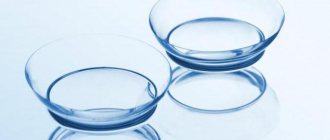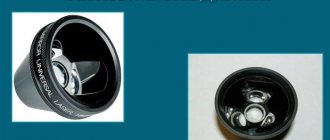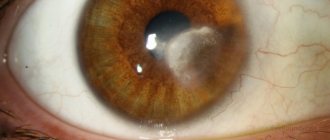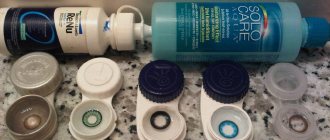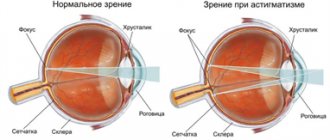More than a dozen years have passed since contact lenses went on sale in optical stores. The “bespectacled people” liked the new invention, because it gave them the opportunity to lead a full life and play sports. And those around you will never guess that you have vision problems. But they failed to completely oust glasses from the market, since there are still people who are afraid to use newfangled optics. Are lenses really harmful or is it just prejudice? To answer this question you need to get to know them better.
Features and types of contact lenses
An ophthalmologist will tell you the rules for using optics. Before prescribing this corrective device, he will conduct a thorough examination and determine whether wearing lenses will harm your health. Each person differs not only in the individual structure of their eyes, but also in their lifestyle, habits, and character. All these seemingly insignificant points are taken into account by the doctor before prescribing the product.
Many patients suffering from vision problems have been using optics for many years and do not suffer from complications or side effects. There is a wide range of contact lenses on the market; the latest technologies are used for their manufacture. Therefore, they can cause harm only if a person “exploits” them incorrectly or “plays doctor” and chooses his own optics.
Don't forget that even the most innovative lens is film. Yes, it is extremely thin and imperceptible, but it still covers the cornea of the eye and thus limits the access of oxygen to it. In addition, it affects metabolic processes in the body and absorbs substances such as:
- Protein that produces the eye;
- Dust and pollution from the external environment;
- Harmful bacteria and medication residues (in the presence of eye pathologies).
| The contact lens quickly becomes dirty and needs daily cleaning and antibacterial treatment. Optics have a limited useful life, so it is extremely important to adhere to the rules for wearing and storing the corrective device. |
The main thing is to choose the right product. All products in this category are divided into two types: therapeutic and aesthetic. The latter do not affect visual acuity; they correct the shade of the iris. They are often used by show business representatives and modern youth.
Therapeutic optics is aimed at eliminating existing deviations in the visual system and is considered a good alternative to glasses. It is recommended to use it in the presence of such ailments as:
- Myopia;
- Astigmatism;
- Farsightedness.
Also, therapeutic lenses are divided into conditional groups according to their main characteristics:
- Type of material used in manufacturing: soft or hard;
- Duration of wearing: one-day; designed for one, two, three months or six months;
- Need for cleansing: every day, once a week or month;
- Possibility of continuous wearing: for twelve hours, for a day, for two days, etc.
There are combination products on sale that combine both aesthetic and health-improving functions. There are also those that are intended only for night use. Regardless of the characteristics of the lens, it must be periodically removed, treated with a disinfectant solution and the eyes given rest.
Those who decide to use an optical device for the first time are afraid of damaging the cornea during the process of removing or putting it on. In principle, this is possible, but it depends only on the patient and his “direct hands.”
Before prescribing lenses, an ophthalmologist must give detailed instructions for their use and conduct a series of training activities. It is important to use a special composition and storage container, tweezers. In this case, the risk of infection will be minimized, and therefore no problems with vision or health will arise. Return to contents
Suitable optics are the key to healthy eyes
To ensure that lenses do not cause harm to the eyes and do not spoil vision, it is necessary to choose them correctly.
To do this, contact an ophthalmologist who will conduct a diagnosis, assess the condition of the visual organs and the patient’s general well-being, and determine the presence of associated complications. The doctor determines the shape and thickness of the lenses, optical power, elasticity of the material, diameter and centering index. As a result, he will write a prescription for optics that will match the characteristics of the patient’s eyes.
Even products of the same size can vary significantly. For example, if the wrong material is chosen, a person develops an allergic reaction, which can cause vision impairment.
Based on the material, correctors can be:
- Soft . Helps improve the condition of myopia or farsightedness. Made from silicone hydrogel or hypoallergenic hydrogel materials.
- Hard (orthokeratological) . Designed to correct astigmatism in later stages of development. Due to the rigid frame, the shape of the cornea is corrected. They are prescribed only by a doctor.
Thanks to modern materials, products for contact correction do not harm the eyes. They freely pass oxygen to the cornea and do not cause overstrain.
According to the planned replacement periods, proofreaders can be one-day, two-week, monthly and quarterly. Traditional models include those that are used for 6-9 months. However, not all ophthalmologists recommend vision correctors for long-term use, as they increase the risk of complications. This factor depends, first of all, on the wishes of the patient.
Lenses or glasses?
The main advantage of contact lenses over their “competitor” is that they do not reduce the viewing angle and do not distort the image that enters the retina. No matter how expensive and high-quality glasses you purchase, they will not allow you to fully examine what is located on the sides. This causes discomfort, because in order to see the necessary object from all sides, you will have to turn your head.
| Glasses negatively affect the proportionality of the face and appearance. In cold weather they fog up, which is why drivers increasingly prefer lenses. They are convenient to use, do not limit the visual field and are practically not felt on the eyes. |
Colored contact lenses: their types and description
Depending on its purpose, this product is divided into 3 subgroups:
- Tinted - suitable for light-eyed people, used to give expressiveness and emphasize the color features of the iris. They are completely colored, but do not change the shade radically, because... remain transparent and do not hide the natural iris.
- Cosmetic - intended to change the color of the eye. Opaque. The middle part is not painted, the rest of the plane is processed using multilayer technology so that the pattern remains inside the lens material, without contact with the eye.
- Decorative – used as part of makeup for specific images (for carnivals, theme parties, filming a video, TV show, etc.). The drawing contains an image of an object, animal, etc. Opaque. They can be with minus diopters and “zero”.
Lenses with a pattern are more suitable for a carnival or theme party.
How viral keratitis is treated is described in detail in the article.
Acuvue 2 Colors
Necessary for concealing existing defects of the eyeball (cataract). Other advantages of the product include:
- possibility of alternative replacement of sunglasses;
- visual load in case of “lazy eye” syndrome (amblyopia);
- correction (if diopters are available).
Infinity - as soft as possible for daily use
Symptoms and treatment methods for viral conjunctivitis in adults can be found here.
How to choose the right contact lenses?
In principle, the ophthalmologist makes the choice for you after an examination. Using medical tests and instruments, he will determine visual acuity and select the appropriate product. After the lenses are selected, the doctor performs fittings, and most often more than one, patients should not experience any discomfort.
Then you need to wait ten minutes, after which the doctor conducts a second examination, examining the eyes and the position of the lenses. If the choice is made correctly, you will be asked to remove and put on the optics yourself several times.
Diopter lenses for vision correction
A device for correcting visual acuity can provoke the development of:
- allergic reactions;
- irritation;
- conjunctivitis;
- redness of the eyeball;
- eye injuries.
The listed pathologies develop only when the product is incorrectly selected or not taken care of. Contact lenses improve the functionality of the visual organs. It is possible to prevent eye infection by observing hygienic standards for wearing the product. It is quite difficult to injure your eyes using the device. By choosing the right vision correction product, you can make everyday tasks easier and return to your favorite professional activity.
What complications and side effects may occur?
The first thing patients encounter when using lenses is a change in the image received on the retina. It becomes clear and voluminous, this creates additional stress on the visual system and can lead to such side effects as:
- Dizziness;
- Migraine;
- Problems with coordination;
- Discomfortable sensations;
- Blurred picture.
Such symptoms are temporary and are associated with increased intraocular pressure. After the optic nerves get used to the new “sensations”, the state of health stabilizes. If side effects do not go away, most likely the optics were chosen incorrectly or the patient is using them incorrectly.
| To “adapt” to the lens, first put it on for thirty minutes, the next day leave it on for an hour, etc. The scheme is prescribed in detail by the ophthalmologist. |
In addition to the above symptoms, ophthalmologists are contacted with the following complaints:
- The optics feel like a foreign object, interfere with blinking, and visual images are blurry. This happens if the lens is put on the wrong way;
- The eyes suffer from dryness, the image is cloudy. Similar signs are observed if a person spends a long time in a stuffy room at a computer or wears a product longer than expected;
- Swelling, redness, burning. There is a high risk of developing conjunctivitis or keratitis. The reason is a violation of the rules of storage and purification.
Infection of the visual organ occurs only through the fault of the patient. It is enough to touch the lens with dirty hands and bacteria rush to “attack”. Makeup is applied after the optics are put on. Use high-quality cosmetics; to remove war paint, use milk or micellar water. Return to contents
What to do if your vision deteriorates while wearing lenses?
The first thing you should do is see an ophthalmologist and undergo a comprehensive eye examination. If you have already been to an appointment, it is advisable to be examined by another specialist and compare the results of the studies. Some patients mistakenly believe that their vision has deteriorated, as they experience discomfort when wearing optics. Often this phenomenon occurs during the adaptation period, when the lenses are perceived by the human body as a foreign object and a process of rejection is observed. In this case, to alleviate the patient’s condition, the use of moisturizing drops is prescribed. They wet the surface of the optics and reduce friction with the cornea.
If during the examination it turns out that vision has indeed deteriorated, it is worth checking whether the means of contact correction (diopters and other parameters) were selected correctly. If necessary, replace the optics with a new pair that matches the correct prescription.
Are you looking for where you can profitably order lenses from global brands? We recommend that you evaluate all the advantages of purchasing goods online on the website of the Ochkov.Net online store. Our assortment includes top products from well-known manufacturers. Delivery of the order is carried out as quickly as possible to all regions of Russia.
Myths about harmfulness
There are countless “fairy tales” and speculations circulating among ordinary people regarding contact lenses. For many “bespectacled” people, such negativity becomes an insurmountable obstacle to “friendship” with a modern device for eliminating eye pathologies.
Myth No. 1: Lenses gradually worsen vision.
It drops whether you use optics or not. Then where did this opinion come from? Everything ingenious is simple: by putting on “correction plates”, a person sees the world around him more clearly and brightly. After he takes them off, the image becomes blurry and the patient decides that his vision has deteriorated significantly.
In reality, the eyes quickly get used to the “pleasant” picture, and the resulting contrast leads to imaginary blindness.
Myth #2: Contact lenses cause eye irritation.
To create modern optics, materials are used that are compatible with the human body; they are not capable of causing irritation to the eyeball. If the product is selected correctly and used in accordance with all the rules, it will not cause negative consequences or discomfort.
| Most lenses have high transmission capacity, so the eye is not afraid of hypoxia. To ensure your eyes rest and are saturated with oxygen in the required amount, be sure to remove your optics before going to bed. Don't forget to clean and disinfect it. |
Myth #3: Contact lenses cure myopia
How does a patient with vision problems think? I’ll buy a couple of lenses, wear them for a week or two, then take them off and I’ll see perfectly. In reality, the therapeutic effect can only be exerted on adolescents and young children. After eighteen years of age, only a surgeon can eliminate myopia or farsightedness.
Myth #4: Wearing lenses is a difficult and painful process.
High-quality optics are not felt on your eyes, sometimes you even forget that you are wearing them. Use does not cause discomfort.
Removing and putting on lenses is a simple process that even a child can master. When choosing a product, the doctor explains in detail and shows how to use it correctly. There are also several practical sessions where the patient himself tries to remove and put on the optics.
Myth #5: Lenses are no different from glasses.
This can only be said by someone who has never broken glasses when falling or cried over a failed date, believing that the culprit was “unattractive glass in a horn-rimmed frame.” Of course, modern models are distinguished by elegance and grace, but lenses give depth and expressiveness to the look. You can play sports in them, swim in the pool, they do not narrow your horizons and additionally provide protection from ultraviolet radiation.
Myth No. 6: the dye in colored lenses is toxic to the eyes and the body as a whole.
The optics used to change the color of the iris use safe pigments. The paint is located between two layers, so there is no direct contact with the mucous membrane. If concerns remain, buy the product in specialized stores.
Myth No. 7: Lenses are very expensive
The price of products depends on many factors, from the manufacturer to the quality of the material. The most expensive ones are those that need to be changed every day. All other options can be afforded by the most ordinary citizen. A set of thirty records will cost one thousand rubles. If you think this is an expensive pleasure, take a closer look at lenses with a long service life.
You can learn a lot of interesting things about myths regarding vision correction devices from the video
Return to contents
Color contact lenses
Colored and scleral lenses are not capable of harming eye health if they are correctly selected and the conditions for wearing them are observed:
Duration of wear
The device can be worn for no more than 8 hours. Since the material from which the product is made does not allow air to pass through.
Sleeping in a product
It is prohibited to sleep in the product. A long period of wearing the device at night contributes to the development of complications.
We recommend reading: What lenses can you sleep in?
Functional characteristics
Carnival eye color changer reduces color rendering and contrast.
Rules of care
Remove and put on the product with clean hands. Every day it is necessary to change the solution for storing the device.
We recommend reading: How to store and care for lenses
Period of use
The period of use of lenses begins from the moment the container is opened. Even if the product is worn only once, it is prohibited to use it for longer than the period indicated on the packaging.
Individual selection
The product cannot be transferred to another person to prevent infection by bacterial microflora. The color contact agent is selected individually by an ophthalmologist.
A device chosen without taking into account the characteristics of the body leads to discomfort and damages vision.
Environment
A smoky or dusty room or the use of aerosols render colored hydrogel unusable. The material from which the device is made quickly absorbs surrounding substances, which can negatively affect eye health.
Age limit
Teenagers should not wear colored hydrogel. Since this category may neglect the rules of wearing colored items to the detriment of their health.
When wearing colored lenses, you need to choose the right makeup products that do not fall off. Particles of cosmetics cause a feeling of sand under the product.
Rules for wearing and storing contact lenses
To minimize the risk of pathologies or negative consequences, “operate” the optics according to the following rules:
- Buy only with a prescription from an ophthalmologist. Once a year, undergo an examination to confirm or change diopters;
- At first, you shouldn’t wear them all day, leave them on for one and a half to two hours. The eyes must get used to the new “accessory”;
- Use artificial tear drops to moisten the eye;
- It is impossible to determine from the appearance of lenses that they are about to expire, so monitor this point carefully. If you purchased weekly items, send them for recycling after seven days. There is no need to rinse or try to clean a fallen “record”; it belongs in the trash bin;
- Do not leave the optics for more than eight hours, give your eyes a rest;
- Be sure to remove your lenses at night;
- You need to touch them with clean and dry hands;
- Wash and disinfect products every day. Use a sterile container and a special solution for storage;
- Girls are advised to put on optics before applying makeup and remove them before cleansing their face.
It is advisable to always have glasses with you so that, if necessary, they can “replace a friend.”
| Do not buy lenses for children under ten years of age, as it is difficult for them to maintain complete personal hygiene. In addition, kids are very active, move a lot and can get injured while playing. |
Useful video
When used correctly, lenses cannot worsen eye health. Complications develop only against the background of improper wearing of means for correcting visual acuity or changing eye color.
Author's rating
Author of the article
Alexandrova O.M.
Articles written
2031
about the author
Was the article helpful?
Rate the material on a five-point scale!
If you have any questions or want to share your opinion or experience, write a comment below.
Prevention measures
To avoid complications and side effects from wearing contact lenses, it is recommended to adhere to the following rules:
- Choose optics only together with a competent ophthalmologist;
- Choose the best option that suits your eyes and carefully follow the instructions for use;
- Observe wearing and disinfection periods;
- Store correctly, purchase a special solution and a container with a lid;
- Do not wear lenses after the expiration date;
- If the product is damaged or worn out, recycle it and buy a new one;
- If you plan to change the manufacturer, consult your doctor first;
- Cigarette lovers or those who work in enterprises with a polluted atmosphere need to change the optical device more often, as it becomes dirty more quickly;
- Alternate the type of optics (glasses/lenses), give your eyes a rest;
- If the eye becomes infected or after suffering from infectious diseases, it is worth replacing the product.
You will learn the opinion of experts about the benefits and harms of optical devices from the video
